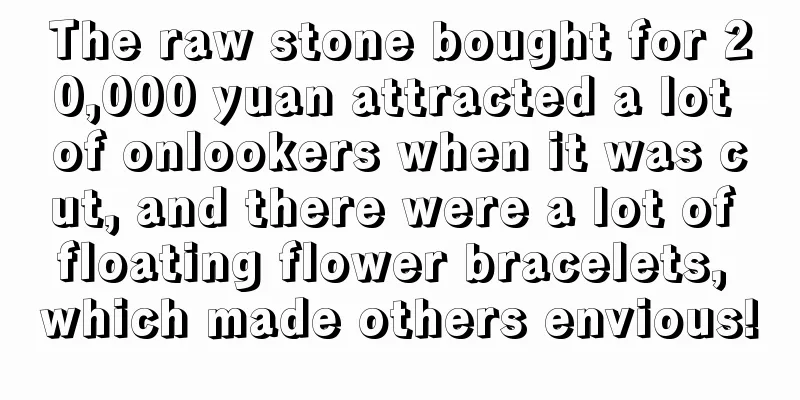Ten identification methods of jadeite, you will be an expert if you learn them

|
Jade is generally divided into three grades, A, B, and C. Only Grade A jade is natural jade, which is what people often call the authentic product. Jadeite is one of the most precious varieties of jade, but the market is flooded with various counterfeit jadeites, making it difficult to distinguish the real from the fake. Here are ten identification methods, I hope they can help you. First, look at the color. Jadeite with particularly bright color and full green is usually very expensive, so you must be especially cautious. Second, measure the hardness. Jade is very hard and can be used to scratch glass. Glass plate (Mohs hardness 5.5) can generally leave streaks on the glass plate, while the jade itself remains intact. Fake jade is generally softer and cannot scratch glass. (Although this may measure hardness, it will still damage the jade, so I personally do not recommend trying this.) Third, listen to the sound. Tap gently with other jade or coins, and listen carefully to the sound of the finished products hitting each other. Natural jade pieces, especially those with good quality, will produce a pure and pleasant "steel sound" when struck. The sound of B-grade jadeite is dull and hoarse. Fourth, look at the color. The color is pure, rich, uniform and appropriate, and it has the potential to maintain and appreciate in value. The ones with a small amount of green heads and brighter colors are better. Fifth, look at the gloss. When jade is illuminated by light, some parts of it appear foggy or spotted, while green jade has varying shades and green dots; while glass products only have bubbles and the color is basically uniform. Sixth, look at the impurities. Use a spotlight to check for hidden colors. If it contains shiny mineral particles and is in clumps, it will seriously affect the quality of the jade. Seventh, look at transparency. When observed under strong light, the higher the transparency, the better. Jade with high transparency is crystal clear and looks vivid and lively no matter what color it is. Eighth, look at the craftsmanship. The best ones are smooth surface, well polished and in good shape. For example, when carving flowers, see whether the lines are smooth and whether the layout is reasonable. Jade jewelry with good workmanship, fine carving and rich cultural connotations is extremely valuable whether for collection, appreciation or wearing. Ninth, look for cracks. It is possible that cracks exist in jadeite raw stones, or they may be caused by later processing. The fewer cracks, the better, and the shorter the length, the better. Tenth, look at the certificate. The issuing agency of the appraisal certificate must be authorized after national qualification certification. Generally, the certificate must have at least the CMA mark, which means that the product is recognized by the relevant national agencies. Carefully check whether the product's photos, total mass, dimensions or other written descriptions are consistent with the certificate. You can query relevant information by entering the certificate number on the appraisal certificate issued by a formal appraisal agency online. fcgc66 fcpf18 |
<<: The “three-look” technique for jadeite will teach you how to distinguish the quality of jadeite!
>>: Teach you how to judge the quality of jade carving in 3 minutes
Recommend
How to easily distinguish whether jadeite is grade A or grade B? Is there any reliable method?
The following article will briefly introduce seve...
Jadeite only rises and never falls, it is a good product for investment and financial management
In the past decade or so, the overall price of ja...
Learn how to look at jadeite under light, and you can also be very professional!
Whether we are in the jade live broadcast room, t...
Share a piece of Moshisha jade window material, how is the finished carved product?
Today I’m going to share with you a piece of Mosh...
What is the carving technique of jade? And in what aspects is it reflected?
The process of processing and carving jade into e...
Jade identification: Characteristics of B-grade jadeite
What I want to share with you today is the charac...
In addition to making beads, the value of leftover jadeite carved like this will instantly increase a hundredfold!
When carving jade, one always has to consider the...
A complete guide to identifying A, B and C grade jadeite, with detailed illustrations and texts
Grade A jadeite: natural jadeite that has not und...
The leaves of emerald trees have accumulated rich and beautiful meanings over the years.
The emerald is verdant and looks just like vibran...
How to choose the real high-quality jadeite rough stone
There is a difference between the green color of ...
The flowers are blooming, and the beauty of emeralds is in full bloom
In today's society, the economy is developing...
Is the bracelet core a scrap? Transformed into a jade dragon, the price increased 10 times
The core of a jade bracelet refers to the part th...
The most valuable thing in jade collection is quality!
Have you ever found that you have a lot of clothe...
Knowing these meanings, your ring will not be worn in vain!
Rings are probably one of the most commonly worn ...
A piece of icy jade bracelet with snow-like cotton texture, the jade carving is so skillful and beautiful!
Today I’m going to share with you the process of ...









